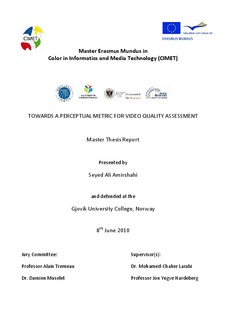| dc.contributor.author | Amirshahi, Seyed Ali | |
| dc.date.accessioned | 2011-04-29T07:24:19Z | |
| dc.date.available | 2011-04-29T07:24:19Z | |
| dc.date.issued | 2010 | |
| dc.identifier.uri | http://hdl.handle.net/11250/143738 | |
| dc.description.abstract | In the last couple of years a huge amount of work has been shifted from works on Image Quality Assessment to Video Quality Assessment. Although some metrics have started to take the temporal aspects of videos into account but still most metrics are focusing on the spatial distortions in videos or in other words applying image quality metrics on individual frames. Also till now most metrics are focusing on the Quality of Service (QOS) rather than the Quality of Experience (QOE). With respect to the mentioned factors we believe that there is a need for a new metric which has a Spatial-Temporal approach and takes QOE into account and so the proposed metric is based on these two main approaches. Because of the spatial-temporal approach we had the metric was named as STAQ (Spatial-Temporal Assessment of Quality). Our proposed method is based on the fact that the Human Visual System (HVS) is sensitive to sharp changes in videos. Keeping this in mind we could reach the conclusion that there will be matching regions in consecutive frames. We took advantage of this point and found these regions and used a Full Reference Image Quality Metric to evaluate the quality of these frames. We also used five different Motion Activity Density groups to evaluate the amount of motion in the video. Our final score was later pooled based on five different pooling functions each representing one of the motion activity groups. In other words we used QOE or information from subjective evaluation for playing a controlling factor role in our method. When the proposed reduced reference metric is compared to ten different state of the art full reference metrics the results show a great improvement in the case of H.264 compressed videos compared to other state of the art metrics. We also reached good results in the case of MPEG-2 compressed videos and videos affected by IP distortion. With respect to the results achieved we could claim that the metric introduced is among the best metrics so far and has especially made a huge progress in the case of H.264 compressed videos. | en_US |
| dc.language.iso | eng | en_US |
| dc.subject | video quality assessment | en_US |
| dc.subject | Image Quality Assessment Metrics | en_US |
| dc.title | Towards a perceptual metric for video quality assessment | en_US |
| dc.type | Master thesis | en_US |
| dc.subject.nsi | VDP::Mathematics and natural science: 400::Information and communication science: 420::Simulation, visualization, signal processing, image processing: 429 | en_US |
| dc.source.pagenumber | 67 | en_US |
